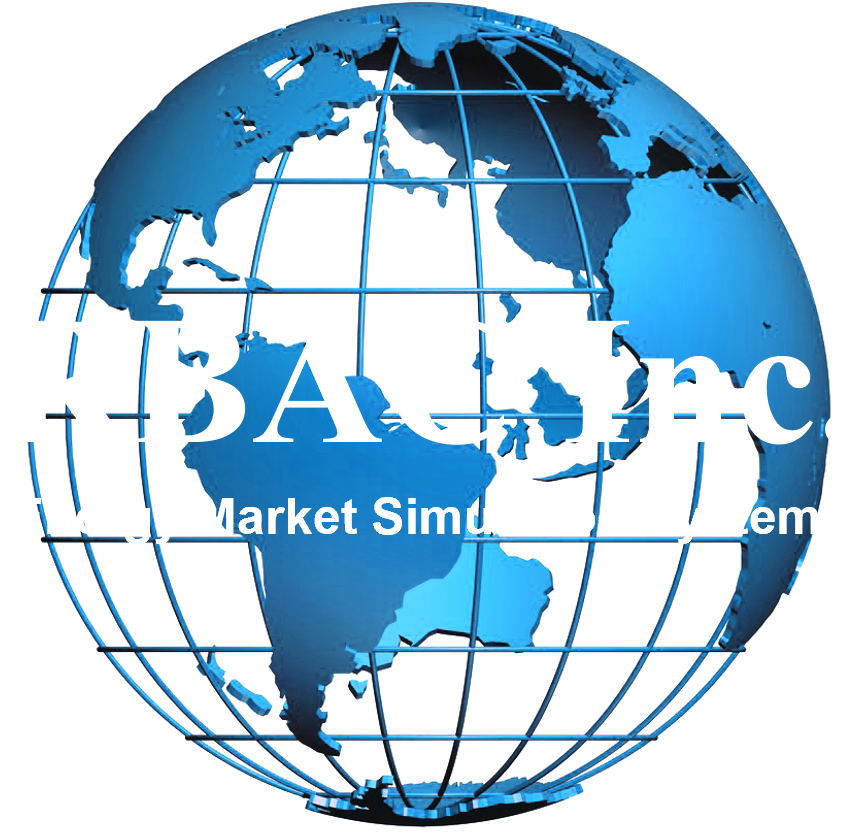1.0 Purpose
RBAC’s GPCM® Market Simulator for North American Gas and LNG™, originally known as the Gas Pipeline Competition Model, is a combination software-database system, whose purpose is to enable its users to build models for analysis of natural gas economics, including the sectors of production, transportation, storage, marketing, and sales to distributors and other large customers. GPCM is the latest in a series of systems and models built by Dr. Robert E. Brooks from the mid-1970s through the present. Making use of the latest PC hardware and software technology as well as advanced computational algorithms, it enables analysts to do more at their desktop than has ever been possible in the past using mainframe computers with earlier, similar software tools.
2.0 Model Structure
Mathematically, GPCM is a network model. It can be diagrammed as a set of “nodes” and “arcs”. Nodes represent production regions, pipeline zones and interconnects, storage facilities, delivery points, and customers or customer groups. The connections between these nodes are called “arcs”. They represent transactions and flows. Some of these are supplier deliveries to pipelines, transportation across zones and from one zone to another, transfers of gas by one pipeline to another, delivery of gas into storage, storage of gas from one period to another, withdrawal of gas from storage, and pipeline deliveries of gas to customers.
In general an arc has four input attributes and two output attributes. The inputs are cost (which may depend on transaction volume), a minimum, a maximum, and a loss factor (representing fuel use and miscellaneous losses). The outputs are the amount of the transaction (the flow) and the economic rent associated with the flow. The latter is defined mathematically as the economic value of a unit increase (decrease) in the upper (lower) bound. It generally applies to pipeline transportation and storage capacity and represents the marginal value of increased capacity.
The economic value of a solution to this problem is identified in economic theory to be the sum of producer and consumer surplus. These concepts are defined for price sensitive supplies and demands. We assume that each supply source and each customer has a well-defined supply or demand curve. The forms for these curves can be quite general. GPCM only requires the quantity to decrease with increasing price for demand curves and to increase with increasing price for supply curves.
The objective function for this “equilibrium” solution has been shown by Nobel Prize winning economist Paul Samuelson to consist of three terms: the integral of the demand price function over demand minus the integral of the supply price function over supply and minus the sum of the transportation and storage costs. By dividing the applicable range of possible prices into a number of small steps, we can approximate the integrals in the objective function by linear terms of the form p * delta q, where delta q is the additional demand (or supply) resulting from the small price change. Because of the form of the supply and demand functions and the objective function, each of these terms will be brought into the solution in an economically sensible order to produce an economically efficient, market-clearing solution. That is, the cheaper supplies will be used before more expensive ones and the customers willing to pay more will be served before those willing to pay less. Thus we are able to use a “linear programming” approach to solve a highly non-linear, complex model of market clearing behavior in the natural gas industry.
3.0 Transportation and Storage Tariff Structure
In general, each transportation and storage transaction cost is parameterized by five values: a unit demand charge, unit firm commodity charge, unit interruptible commodity charge, a “full discount quantity” (FDQ) and a “zero discount quantity” (ZDQ). The cost model for such transactions assumes that, for a price, some amount of the capacity could be reserved for certain customers. The cost of such capacity reservations will be the unit demand charge times the capacity reserved plus the unit firm commodity charge times the amount actually used. The cost for interruptible service (interruptible commodity charge) will be lower on average than the total cost for firm service, but higher than the firm commodity charge. The model says that if demand for the capacity is higher than the ZDQ, the pipeline will be able to charge the full interruptible rate for transportation. If not then it will have to discount. The amount of the discount in this model is maximal when demand falls to FDQ or lower: then the price of transportation is equal to the firm commodity charge. The discount declines linearly as demand increases from the FDQ up to the ZDQ. For all demand greater than or equal to ZDQ, the price is the full interruptible commodity charge, i.e. no discounting is required.
Storage transactions work the same way. There are three storage transactions: injection, storage, and withdrawal. Injection and withdrawal have the structure just defined. Storage has a simpler structure: a constant unit cost per period, which may be zero. The user may model a situation where gas is transported to a storage location on one rate schedule, injected and withdrawn under another, and delivered to another location under a third. The user may also model a “bundled” structure involving movement from one location to the storage location and then downstream to yet a third, all under the same rate structure.
Marketers are modeled as a single undifferentiated sector in GPCM. This sector is assumed to mediate all transactions in the model. It is the sector which makes the market by linking gas supply to gas demand through the pipeline and storage system.
The bulk of the economic rent due to capacity restrictions is generally distributed to the marketing sector. The assumption is basically that the marketers are able to buy at market conditions, sell at market conditions, and acquire transportation at prices fixed in the short term. Therefore, short term economic rents will not be acquired by the pipeline sector and will go to the marketing sector. Suppliers and customers owning Firm Transportation earn the remainder of these rents. Their rents may be earned by reselling their capacity to others or by using the F/T themselves.
4.0 User Interface
The user interface is the principal analysis tool contained in the GPCM system. It consists of a set of queries, macros, modules, forms, and reports contained in a Microsoft Access file. The user interacts with this interface through Access “Forms”. Forms contain data from the database and controls such as button for causing actions to be done. The data displayed in forms is stored in database tables in a separate Access file. These tables are “attached” to the user interface so that they can be viewed and modified by the analyst.
5.0 Database
The database file consists of a number of data tables for input and output. The data inputs are primarily of three types: tables representing the basic entities of the model (suppliers, supply regions, customers, demand regions, pipeline zones, storage facilities), tables relating these entities representing the structural linkages in the model (the arcs), and the quantitative data representing supplies, demands, tariffs, capacities, fuel use, etc. The GPCM user typically populates the database via Windows clipboard copy-paste operations from Excel or other spreadsheets. Alternatively, the user can utilize GPCM’s built-in data import routines.
6.0 RBAC Network Optimizer
RBAC Network Optimizer is a specialized linear programming algorithm designed specifically to solve network models such as that used in GPCM™. In benchmarking tests on a large variety of such problems, it has proven to be world class in speed and functionality. RBAC Network Optimizer has been extended to handle the linearized approximations of non-linear supply, demand, and transportation cost functions required for the solution of the GPCM model.
7.0 Outputs
GPCM contains powerful and flexible tabular and graphical output capabilities. In addition the entire solution can be exported to an Excel spreadsheet for further analysis and reporting.
Following is a list of the pre-packaged screen and hardcopy reports available in GPCM:
- Results Summary / Detail
- Pipeline Usage Summary
- Supplier Deliveries Detail / Summary
- Customer Receipts Detail / Summary
- Supplier Revenue Report
- Customer Cost Report
- Transport Results Detail
- Transport Zone Prices
- Transport Zone Basis
- Interconnect Basis
- Transport Revenue
- Storage Revenue
- Transport Zone Utilization
- Transport Link Utilization
- Storage Utilization
- Storage Balance
Report 9 allows the user to find the basis (market price spread) between any two pipeline zones identified in the model in any period of the scenario. The report has a graphical capability which allows the user to produce a time series plot of the basis forecast over the forecast horizon of the case.
The Results Summary Report is an aggregate report of the gas and dollar flows among the various sectors of the gas industry. It shows the forecast aggregate average supply price, average unit return to the marketing sector, average transportation and storage cost per unit delivered, and average cost to customers represented in the model. There is also a graphical routine which allows the user to produce histograms comparing any of the elements of the case summary report for various cases.
Finally, GPCM has a general purpose graphing capability the analyst can use to plot time series of inputs and / or outputs either one at a time or overlayed against each other. For example, the analyst could plot the time series of market clearing prices in two different regions in the same scenario or in multiple scenarios in order to get a visual perspective on their relative values.
For additional information please contact James Brooks at (281) 506-0588 ext. 126 or click here to contact.


